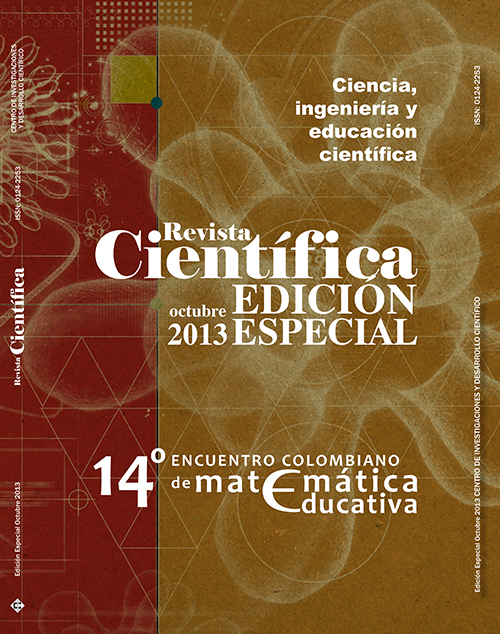DOI:
https://doi.org/10.14483/23448350.6447Published:
10/24/2013Issue:
Vol. 17 No. 2 (2013): June-December 2013Section:
Research ArticlesÁmbitos de investigación en invención de problemas matemáticos
Keywords:
Otras nociones de Educación Matemática, resolución de problemas, planteamiento de problemas, problemas. (es).Downloads
Abstract (es)
La invención de problemas es una línea de investigación que surge de los estudios realizados sobre la resolución de problemas matemáticos y es reconocida como actividad importante dentro del salón clase. De ahí surge un interés creciente por investigar este tema desde diferentes perspectivas,
obteniendo una amplia variedad de resultados. De esta forma
presentamos algunos ámbitos de investigación en invención de problemas y sus principales resultados. El estudio muestra que la investigación en invención de problemas aporta resultados valiosos en la mejora de la educación matemática como en la aportación de elementos teóricos sobre el tema.
References
Ayllón¸M. (2004). Invención de problemas con números naturales, enteros negativos y racionales. Tarea para profesores de educación primaria en formación. Memoria de Tercer Ciclo. Granada: Universidad de Granada
Balka, D. S. (1974). Creative ability in mathematics.
Arithmetic Teacher, 21, 633-636.
Castro, E (2008). Resolución de problemas: ideas, tendencias e influencias en España. En R. Luengo, B. Gómez, M. Camacho & B. Lorenzo (Eds.), Investigación en Educación Matemática XII (pp 113-140). Badajoz: Sociedad Española de Investigación en Educación Matemática, SEIEM.
Cázares, J. (2000). La invención de problemas en escolares de primaria: un estudio evolutivo. Memoria de tercer ciclo. Granada: Universidad de Granada
Ellerton, N. F. (1986). Children’s made up mathematics
problems: A new perspective on talented mathematicians. Educational Studies in Mathematics, 17, 261-271. English, L. D. (1997). The development of fifth grade children’s problem posing abilities. Educational Studies in Mathematics, 34,
-217.
Espinoza, J. (2011). Invención de problemas aritméticos
por estudiantes con talento matemático: Un estudio exploratorio. Memoria de Tercer Ciclo. Granada: Universidad de Granada
Kesan, C., Kaya, D & Güvercin, S. (2010). The effect of problem posing approach to the gifted student’s mathematical abilities. International Online Journal of Educational Sciences, 2(3), 677-687.
Krutetskii, V.A (1976). The psychology of mathematical abilities in school children. Chicago: University of Chicago Press.
Leung, S. K., & Silver, E. A. (1997). The role of task format, mathematics knowledge, and creative thinking on the arithmetic problem posing of prospective elementary school
teachers. Mathematics Education Research Journal, 9(1), 5-24.
Moses, B., Bjork, E. & Goldenberg, E. R (1990): Beyond problem solving: problem posing. En T. J. Cooney y C. R. Hirsch (eds.), Teaching and Learning Mathematics in the 1990s. Yearbook: National Council of Teachers of Mathematics, 83-91.
Polya, G. (1979). Cómo plantear y resolver problemas.
México: Trillas.
Pelczer, I., & Gamboa F. (2008). Problem posing strategies of mathematically gifted students. En R. Leikin (Ed.), Proccedings of the 5th International Conference on Creativity in Mathematics and the Education of Gifted Students, (pp 193-199). Haifa, Israel.
Silver, E. A. (1994). On mathematical problem posing. For the Learning of Mathematics, 14(1), 19-28.
Silver, E. A., & Cai, J. (1996). An analysis of arithmetic problem posing by middle school students. Journal for Research in Mathematics Education, 27(5), 521-539.
Silver, E. A., & Cai, J. (2005). Assessing students’ mathematical problem posing. Teaching Children Mathematics, 12(3), 129-135.
How to Cite
APA
ACM
ACS
ABNT
Chicago
Harvard
IEEE
MLA
Turabian
Vancouver
Download Citation
License
When submitting their article to the Scientific Journal, the author(s) certifies that their manuscript has not been, nor will it be, presented or published in any other scientific journal.
Within the editorial policies established for the Scientific Journal, costs are not established at any stage of the editorial process, the submission of articles, the editing, publication and subsequent downloading of the contents is free of charge, since the journal is a non-profit academic publication. profit.



